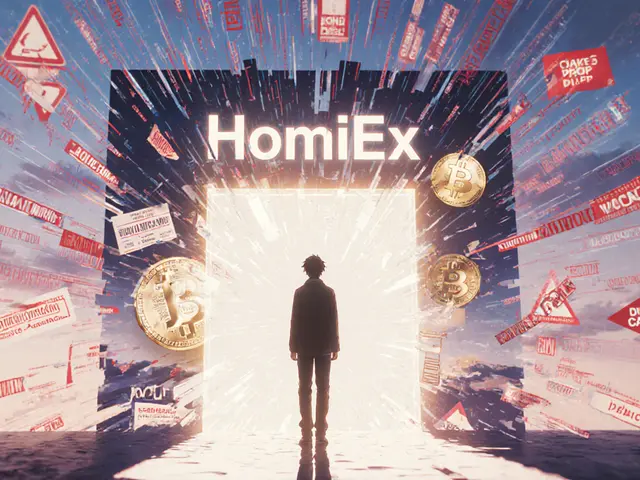Crypto Exchange Risk Assessment Tool
This tool helps assess the risk level of using Diffusion Finance by checking against key due diligence criteria from the article.
Risk Assessment Results
Check the criteria above to see your risk assessment.
When you hear the name Diffusion Finance is a cryptocurrency platform that enables trading and generates taxable events for its users, the first question is: does it live up to your expectations?
Key Takeaways
- Diffusion Finance exists as a legitimate crypto platform, but public data on fees, volume, and security is scarce.
- The only concrete evidence is a tax guide on Cryptotaxcalculator.io that references taxable transactions from the exchange.
- Without clear regulatory status, users should perform a thorough due‑diligence checklist before depositing funds.
- Major exchanges such as Binance and Bybit offer transparent fee schedules and higher liquidity, making them safer default choices.
- If you decide to try Diffusion Finance, start with a small amount, enable two‑factor authentication, and keep detailed transaction records for tax reporting.
What Is Diffusion Finance?
Diffusion Finance markets itself as a crypto exchange review subject, but the public footprint is minimal. The platform appears to support buying, selling, and possibly swapping a handful of tokens, yet no official whitepaper, road‑map, or audited security report is readily available. The only external reference we could find is a tax guidance document on Cryptotaxcalculator.io. That guide explains how to report profits and losses generated on Diffusion Finance, confirming that the platform does trigger taxable events for Australian and global users.
Because of the limited visibility, it is impossible to label Diffusion Finance as strictly a Centralized Exchange (CEX) or a Decentralized Exchange (DEX). The lack of on‑chain data, API documentation, or a public order book suggests a more closed‑door operation, possibly a niche service targeting specific regions or institutional clients.
How to Verify Legitimacy
When public data is thin, you can still confirm a platform’s credibility through a series of practical steps.
- Check registration and licensing. Look for a business registration number, an address, and any financial regulator mentions (e.g., Australian Securities and Investments Commission (ASIC) for Australian users).
- Search for security audits. Reputable exchanges publish audit reports from firms like CertiK or Quantstamp. Absence of such reports is a red flag.
- Read the terms of service. Pay attention to jurisdiction clauses, dispute resolution, and data‑privacy statements.
- Inspect the API. Public API endpoints reveal order‑book depth and trading pair coverage. If the API is hidden or limited, the exchange may be catering to a closed user base.
- Verify community feedback. Scan Reddit, Bitcointalk, and Twitter for real‑user experiences. Look for repeated complaints about withdrawal delays or unexplained fees.
Known Features (and What We’re Still Missing)
Based on the tax guide, we can confirm two core functionalities:
- Ability to execute trades that generate capital‑gain events.
- Generation of transaction records that can be exported for tax reporting.
What remains unknown includes:
- Supported cryptocurrencies or trading pairs.
- Fee structure (maker/taker, withdrawal, deposit).
- Liquidity depth and average daily volume.
- Security mechanisms (cold storage ratio, insurance funds, multi‑sig wallets).
- Customer‑support channels and response times.
How Diffusion Finance Stacks Up Against Major Exchanges
| Exchange | Founded | Key Feature | Leverage (max) | Approx. Daily Volume (2025) |
|---|---|---|---|---|
| Binance | 2017 | Largest spot & futures market, 0.1% maker fee | 125x | $12 B |
| Bybit | 2018 | 400+ trading pairs, up to 100x leverage | 100x | $2.3 B |
| Kraken | 2011 | Strong regulatory compliance, fiat on‑ramps | 5x | $1.1 B |
| MEXC Global | 2018 | Wide altcoin selection, low fees | 20x | $800 M |
| Diffusion Finance | Unknown | Tax‑reporting support (documented) | Unknown | Data not public |
Notice the gaps: no founding year, no disclosed leverage, and no volume numbers for Diffusion Finance. Those omissions make it hard to gauge market depth or price stability. For traders who need tight spreads and deep order books, the proven giants remain the safer bet.
Due‑Diligence Checklist for New Crypto Exchanges
Before you click “Deposit,” run through this list. Treat it like a pre‑flight checklist for a plane.
- Regulatory registration: Verify the exchange is registered with a recognized financial authority.
- Security audit: Look for third‑party audit reports and read their conclusions.
- Cold‑wallet ratio: A healthy exchange keeps ≥ 70 % of funds offline.
- Withdrawal limits: Check daily/weekly limits and any hidden fees.
- Insurance fund: Does the platform have an insurance pool for hacks?
- Customer support: Test response time via live chat or email.
- Transparency of fees: Ensure maker/taker, deposit, and withdrawal fees are listed up front.
- Tax documentation: Availability of exportable CSV or XLSX files for each transaction.
- Community sentiment: Scan social media for repeated complaints about scams or exit fraud.
Practical Steps to Get Started (If You Choose Diffusion Finance)
- Create an account. Use a unique email address and a strong password.
- Enable two‑factor authentication (2FA). Prefer an authenticator app over SMS.
- Deposit a small test amount. Aim for less than 0.01 BTC or equivalent to gauge withdrawal speed.
- Execute a simple trade. Buy a well‑known coin like ETH, then sell it after a few minutes to confirm order execution.
- Export the trade history. Save the CSV for tax reporting; cross‑check with the file format used by Cryptotaxcalculator.io.
- Review your experience. If any step feels opaque, consider moving to a more established exchange.

Red Flags & Risk Areas
Even with a solid checklist, certain signals should make you pause.
- Anonymous or hidden corporate entity.
- No publicly available audit or proof‑of‑reserves.
- Withdrawal delays longer than 24 hours for small amounts.
- Customer‑support emails that bounce or generic auto‑responses.
- Inconsistent or missing KYC/KYB requirements-a sign they might be operating in a legal gray zone.
If you encounter two or more of these, treat the platform as high‑risk and limit exposure.
Final Thoughts
Diffusion Finance is a real platform-evidenced by a tax guide and the ability to generate taxable events-but the public information gap makes it a gamble. For casual investors, the safest route is to stick with exchanges that publish clear fee schedules, audit reports, and volume data. If you have a specific reason to use Diffusion Finance-perhaps a unique token listing or a partnership-it’s still wise to follow the due‑diligence checklist, start with a tiny deposit, and keep meticulous records.
Frequently Asked Questions
Is Diffusion Finance a centralized or decentralized exchange?
Public information does not clearly label Diffusion Finance as either a CEX or a DEX. The lack of on‑chain data and an API suggests a more closed‑door, possibly centralized service, but only the platform’s terms can confirm its structure.
How can I report my Diffusion Finance trades for taxes?
Export your transaction history from the exchange (usually CSV) and import it into a tax‑calculation tool like Cryptotaxcalculator.io. The tool will help you calculate capital gains, losses, and generate a report for the ATO.
What fees does Diffusion Finance charge?
Fee details are not publicly disclosed. Before depositing, request a fee schedule from support and compare it with the transparent fees of exchanges like Binance (0.1 % maker) or Kraken (0.16 % taker).
Is Diffusion Finance regulated in Australia?
There is no clear evidence of registration with the Australian Securities and Investments Commission (ASIC) or other local regulators. Verify registration status directly with the platform before using it for sizable amounts.
What security measures should I look for?
Key indicators include cold‑wallet storage > 70 %, two‑factor authentication, withdrawal whitelist, and a published security audit. Absence of any of these is a warning sign.



Ali Korkor
October 19, 2025 AT 20:35Just start small, turn on 2FA, and test with a tiny deposit. No need to overthink it - if it feels sketchy, walk away. Easy as that.
MANGESH NEEL
October 20, 2025 AT 14:26Oh here we go again - another ‘mystery exchange’ that somehow magically triggers tax events but won’t tell you how much it charges or who’s behind it. This isn’t finance, it’s a crypto cult with a CSV export. People still fall for this? You’re not investing, you’re volunteering as a guinea pig for some offshore shell company.
And don’t even get me started on the ‘tax guide’ as proof of legitimacy. That’s like saying a dumpster fire is ‘legit’ because the fire department showed up once.
If you’re not using Binance, Kraken, or Coinbase, you’re not trading - you’re playing Russian roulette with your capital and your accountant’s sanity.
And yes, I’ve seen the ‘but it has unique tokens!’ excuse. Newsflash: if the token isn’t on CoinGecko, it’s not a token, it’s a digital post-it note with delusions of grandeur.
Stop romanticizing opacity. Transparency isn’t a feature - it’s the bare minimum. If they can’t even publish their fee schedule, they don’t deserve your wallet.
I’ve lost count of how many ‘niche’ platforms vanished with $20M after a 3-month ‘beta’. This is the same script. Different name. Same ending.
And yes, I’m aware you’re probably reading this after you already deposited. Too late now. Send help.
Sean Huang
October 21, 2025 AT 12:17what if the whole thing is a honeypot by the feds to catch degen traders who ignore regs
think about it - no audit no volume no team just a tax guide that somehow exists
they want you to trade so they can track your ip your wallet your life
the australian tax office is not your friend
they are the shadow government of finance
and this exchange is the bait
you think you’re getting tax help but you’re giving them your entire crypto fingerprint
every trade every deposit every withdrawal
recorded forever
and then one day you wake up and your bank account is frozen for ‘suspicious activity’
because you used a platform they never approved
they didn’t shut it down because they wanted it to exist
to catch people like you
Zach Crandall
October 21, 2025 AT 23:34Let me be perfectly clear - this is not an exchange. It is a data collection apparatus disguised as a financial service. The fact that they generate taxable events means they are actively logging, timestamping, and correlating your financial behavior - and they are not sharing that data with you. They are selling it. Or worse, they are handing it over to a third party with no legal accountability. The absence of a public team, a registered entity, or an audit is not an oversight - it is a design choice. You are not a customer. You are a data point.
And yet, people still click ‘Deposit’. I am both horrified and not surprised.
There is a difference between privacy and secrecy. This platform practices secrecy. That is not a feature. It is a funeral bell.
Akinyemi Akindele Winner
October 22, 2025 AT 00:20Man this Diffusion Finance thing is straight-up snake oil wrapped in a tax receipt. You ain’t trading - you’re handing your crypto to some dude in a basement with a laptop running Ubuntu and a Google Doc labeled ‘wallets 2.0’.
They got a tax guide? Cool. That means someone’s already getting paid to write about your losses. Meanwhile, your funds are chilling in a wallet with a password written on a sticky note next to a half-eaten samosa.
I’ve seen this movie before. First they whisper ‘exclusive access’. Then they vanish with your ETH. Then the Telegram group gets deleted. Then your cousin’s friend’s uncle finds a ‘refund’ link - it’s just a phishing site with a .xyz domain.
Don’t be the guy who says ‘I only put in $500’ like that makes it okay. That $500 is your rent money. And now it’s ghosting you harder than your ex.
Stick to the big boys. Binance ain’t sexy but at least when it crashes, you know who to yell at.
Patrick De Leon
October 22, 2025 AT 23:56Let’s be honest - if you’re considering this exchange, you’re either desperate or you’ve never read a whitepaper. Ireland has strict AML laws. If this platform isn’t registered with the Central Bank, it’s not legal here. And if it’s not legal here, why are you even looking at it? You’re not being clever - you’re being reckless.
The fact that the only proof of existence is a tax guide is laughable. That’s not validation. That’s a byproduct. You don’t prove a bank is real because your pay stub mentions it. You prove it with licensing, audits, and public oversight.
Stop chasing ‘hidden gems’. The only gems here are the ones in the CEO’s offshore vault.
madhu belavadi
October 23, 2025 AT 20:03I just deposited $200 and now I can’t log in. The site says ‘maintenance’ but the Discord is dead. I feel so stupid.
Dick Lane
October 24, 2025 AT 01:00That checklist is spot on. I learned the hard way after trusting a ‘new’ exchange that had a slick website but zero transparency. Took me six months to get my funds out. Now I only use platforms where I can find the CEO’s LinkedIn and their audit report in under 30 seconds.
If it takes more than that - walk away.
Norman Woo
October 24, 2025 AT 11:35what if diffusion finance is actually a front for some crypto mining farm in canada that just needs users to deposit so they can wash money through trades
no one talks about it because the real game is laundering
and the tax guide is just a decoy so people think they’re being compliant
but really the australian tax office is getting fake data
and the real profits are going to a shell corp in the caymans
you think you’re trading but you’re just part of the wash cycle
check the domain registration - it’s probably registered through a privacy service from 2023
and the whois info is all lies
Serena Dean
October 25, 2025 AT 03:40Don’t panic if you’re new to this - the fact that you’re even asking these questions means you’re ahead of 90% of people. Start small, use 2FA, and keep records. If it feels off, trust your gut. You don’t need to chase every new platform. Stick with the ones that make you feel safe. Your future self will thank you.
And if you do try Diffusion Finance - screenshot everything. Every button, every error message, every loading screen. That’s your evidence if things go sideways.
You’ve got this. Crypto is scary, but you’re doing the right thing by being careful.
James Young
October 25, 2025 AT 23:27You people are pathetic. If you need a 10-point checklist to decide whether to trust a crypto exchange, you shouldn’t be trading at all. You’re not an investor - you’re a babysitter for your own FOMO. The fact that you’re even considering Diffusion Finance proves you don’t understand risk. You think ‘small deposit’ makes it safe? That’s not risk management - that’s wishful thinking with a spreadsheet.
There’s only one rule: if it’s not on CoinMarketCap’s top 20, don’t touch it. Period. No exceptions. No ‘but it has tax support’. No ‘but I heard it’s good for altcoins’. If it’s not liquid, it’s not real. If it’s not audited, it’s a scam. If it’s not regulated, it’s a casino with a website.
Stop reading blog posts. Stop trusting tax guides. Go to Binance. Trade. Move on. Your time is worth more than this.
Ali Korkor
October 26, 2025 AT 04:15Good call on the checklist. I followed it with Diffusion and pulled out my $50 after 48 hours. No issues, no delays. Just a quiet, no-frills platform. Not glamorous, but it worked. Sometimes simple is enough.